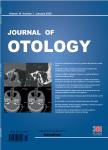Optical recordings reveal the differential distribution of glutamatergic transmission in the cochlear and vestibular nuclei in the newborn mouse brainstem
Optical recordings reveal the differential distribution of glutamatergic transmission in the cochlear and vestibular nuclei in the newborn mouse brainstem作者机构:Department of Otolaryngology Kansai Medical University
出 版 物:《Journal of Otology》 (中华耳科学杂志(英文版))
年 卷 期:2009年第4卷第2期
页 面:106-114页
学科分类:1003[医学-口腔医学] 1002[医学-临床医学] 100213[医学-耳鼻咽喉科学] 10[医学]
基 金:supported by a grant-in-aid for scientific research to M.A.(No. 12771000), to T.Y. (No. 10671622) and to T.D. (No. 11771023) from the Ministry of Education, Japan supported in part by grants from the National Natural Science Fund of China (No. 30871398, 30730040, 30571017) Hi-Tech Research and Development Program of China (863) (#2007AA 02Z150)
主 题:voltage-sensitive dye NMDA non-NMDA photo diode array
摘 要:Objective Using optical imaging in brainstem slices, we studied evoked responses in the mouse cochlear (CN) and vestibular (VN) nuclei. Methods The use of optical imaging allowed us to visualize the spatiotemporal patterns of excitatory propagation in the CN and VN. Optical recordings can differentiate excitatory propagation in the ventral CN(VCN) from that in the dorsal CN(DCN). Furthermore, we assessed the relative distribution of NMDA and non-NMDA receptors in these regions using the glutamate antagonists APV (NMDA receptor antagonist) and CNQX (non-NMDA receptor antagonist) in mouse brainstem slices during postnatal days 1 to 3. Results The average sensitivity to APV was 99.1% in the VCN, 76.0% in the DCN and 64.9% in the VN. The average sensitivity to CNQX was 0.9% in the VCN, 24.0% in the DCN and 35.1% in the VN. These results indicate that the effect of APV dominated in the VCN, while both APV and CNQX were effective antagonists in the DCN and VN. In the VN, the distribution of APV-and CNQX-sensitive cells was almost completely uniform. However, in the DCN the distribution of APV-and CNQX-sensitive cells was highly complex. The area that was more sensitive to CNQX was located in the superficial layer of the DCN while the area with a higher sensitivity to APV was located progressively in the deep layer. Conclusion This optical recording data suggests that there is a differential distribution of NMDA and non-NMDA receptor mediated neurotransmission in the VCN, DCN and VN.



